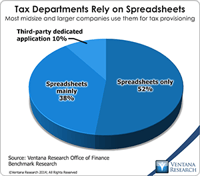The steady march of technology’s ability to handle ever more complicated tasks has been a constant since the beginning of the information age in the 1950s. Initially, computers in business were used to automate simple clerical functions, but as systems have become more capable, information technology has been able to substitute for increasingly higher levels of human skill and experience. A turning point of sorts was reached in the 1990s when ERP, business intelligence and business process...
Read More
Topics:
Sustainability,
ERP,
GRC,
Office of Finance,
audit,
finance transformation,
Human Capital,
LongView,
Tax,
Analytics,
Business Analytics,
Governance, Risk & Compliance (GRC),
Oracle,
Business Performance Management (BPM),
CFO,
Financial Performance Management (FPM),
Vertex,
FPM,
Innovation Awards,
Thomson-Reuters multinational
The International Integrated Reporting Council (IIRC) recently published a draft framework outlining how it believes businesses ought to communicate with their stakeholders. In this context the purpose of an “integrated report” is to promote corporate transparency by clearly and concisely presenting how an organization’s strategy, governance, and financial and operational performance will create value for shareholders and other stakeholders in both the short and the long term. Such a report...
Read More
Topics:
Sustainability,
Office of Finance,
closing,
XBRL,
Business Analytics,
Business Intelligence,
Information Applications (IA),
Information Management (IM),
financial reporting,
FPM,
SASB,
SEC
Infor described this year’s Inforum user group meeting as a coming-out party for a large startup company. Such a debut was necessary because Infor had been operating in something of a stealth mode for the past three years: a limited marketing presence, no unified message and a weak, sometimes inconsistent brand identity. It also needed to formally introduce Infor to customers of Lawson, the ERP supplier it acquired last year. The “startup” designation is meant to signal that Infor has been able...
Read More
Topics:
Performance Management,
Salesforce.com,
SAP,
Social Media,
Sustainability,
ERP,
Human Capital Management,
Marketing,
Operational Performance Management (OPM),
Epiphany,
expense management,
Lawson,
Business Analytics,
Business Collaboration,
Business Intelligence,
Business Mobility,
Cloud Computing,
Governance, Risk & Compliance (GRC),
IBM,
Operational Intelligence,
Oracle,
CRM,
Customer Performance Management (CPM),
finance,
Financial Performance Management (FPM),
Infor,
Information Applications (IA),
Information Management (IM),
IT Performance Management (ITPM),
Sales Performance Management (SPM),
Supply Chain,
Supply Chain Performance Management (SCPM),
Workforce Performance Management (WPM),
Financial Performance Management
I’ve been advocating more intelligent use of spreadsheets for the better part of a decade. Ventana Research coined the term “enterprise spreadsheet” in 2004 to describe software applications that marry a Microsoft Excel user interface with a business rules server and a relational or multidimensional data store. This approach offers the best of both worlds in the sense of taking advantage of widespread familiarity and training with Excel while substantially reducing issues stemming from the...
Read More
Topics:
Planning,
Social Media,
Sustainability,
Operational Performance Management (OPM),
Reporting,
Budgeting,
Analytics,
Business Analytics,
Business Collaboration,
Business Intelligence,
Business Mobility,
Cloud Computing,
Governance, Risk & Compliance (GRC),
Business Performance Management (BPM),
Customer Performance Management (CPM),
Data,
Financial Performance Management (FPM),
Information Applications (IA),
Information Management (IM),
IT Performance Management (ITPM),
Sales Performance Management (SPM),
Supply Chain Performance Management (SCPM),
Workforce Performance Management (WPM),
Financial Performance Management,
Microsoft Excel,
Spreadsheets
The earthquake, tsunami and nuclear plant trifecta that devastated Japan has had a negative impact also on companies that embraced the concept of managing a lean supply chain – one that minimizes inventories at each stage. If news accounts are to be believed, there seem to be legions regretting that decision as disruptions caused by the disasters have a ripple impact, hampering manufacturers’ ability to deliver goods worldwide. But although current events are a wake-up call highlighting the...
Read More
Topics:
Performance Management,
Sustainability,
Human Capital Management,
Marketing,
Operational Performance Management (OPM),
Analytics,
Business Analytics,
Business Collaboration,
Cloud Computing,
Governance, Risk & Compliance (GRC),
Business Performance Management (BPM),
Financial Performance Management (FPM),
IT Performance Management (ITPM),
Supply Chain,
Supply Chain Performance Management (SCPM)
Years ago I was given a tour of a company’s factory by the CEO who was credited with engineering its recent turnaround. We were walking along a gallery one story above the shop floor when he pointed down to it and told me that when he first looked down on this scene he saw people dashing madly back and forth. Rather than taking that as a good sign of a busy factory, he said it was a clear indication to him of how inefficient the operation was and why the company was losing money. He immediately...
Read More
Topics:
Sustainability,
Environment Management,
CFO,
finance,
Green
Ecology and economy are two words with the same root. Similarly, the focus on sustainability in business has two sorts of "green" impacts: on the environment and (if you do it right) on the bottom line. Perillon has an on-demand and cloud computing-based solution for companies that want to manage their double-green sustainability efforts more effectively. Perillon Workspace Suite offers "sustainability performance management" for organizations in energy and environmental management. It delivers...
Read More
Topics:
Sustainability,
Perillon,
Business Performance Management (BPM),
Financial Performance Management (FPM),
Supply Chain Performance Management (SCPM),
Financial Performance Management












